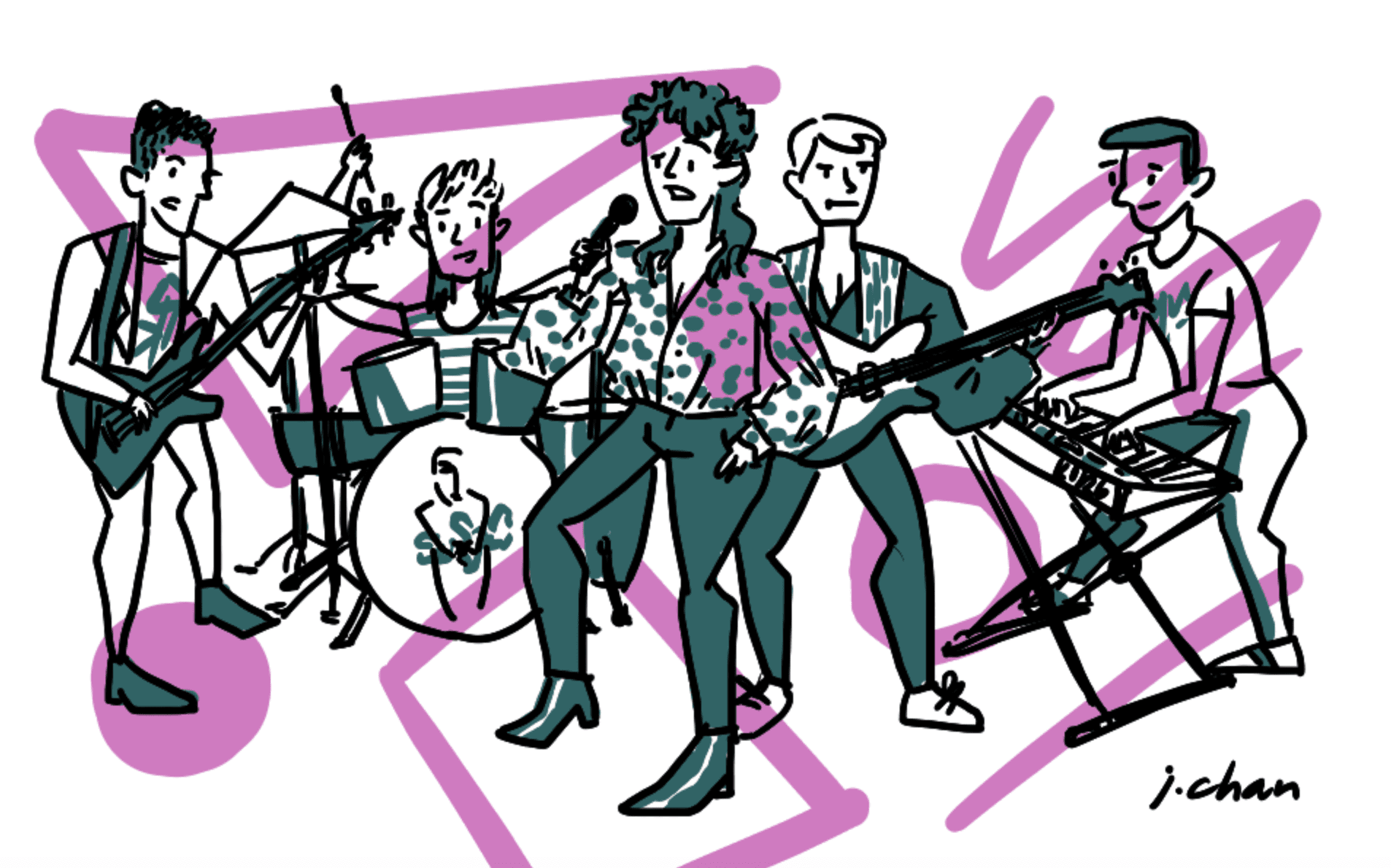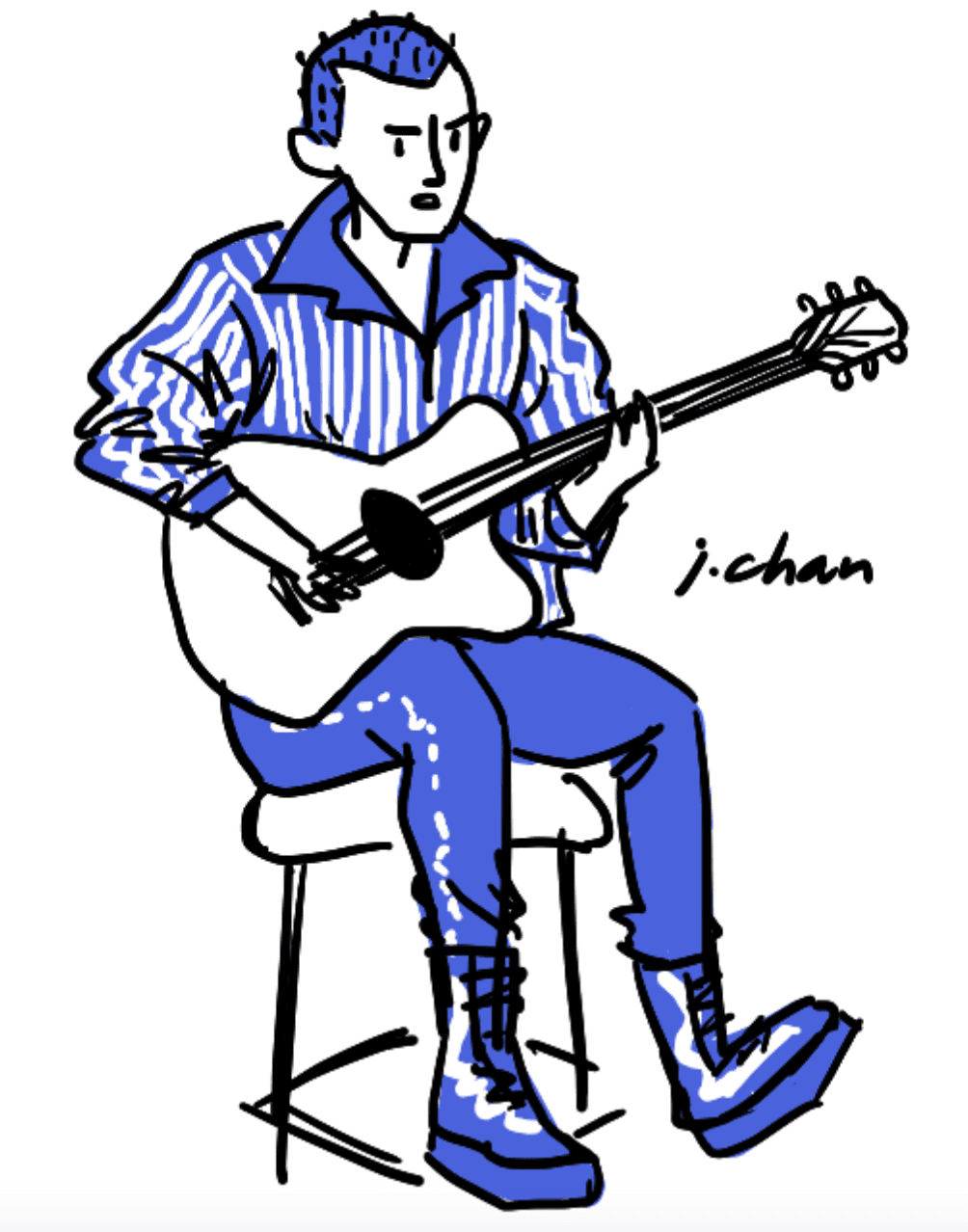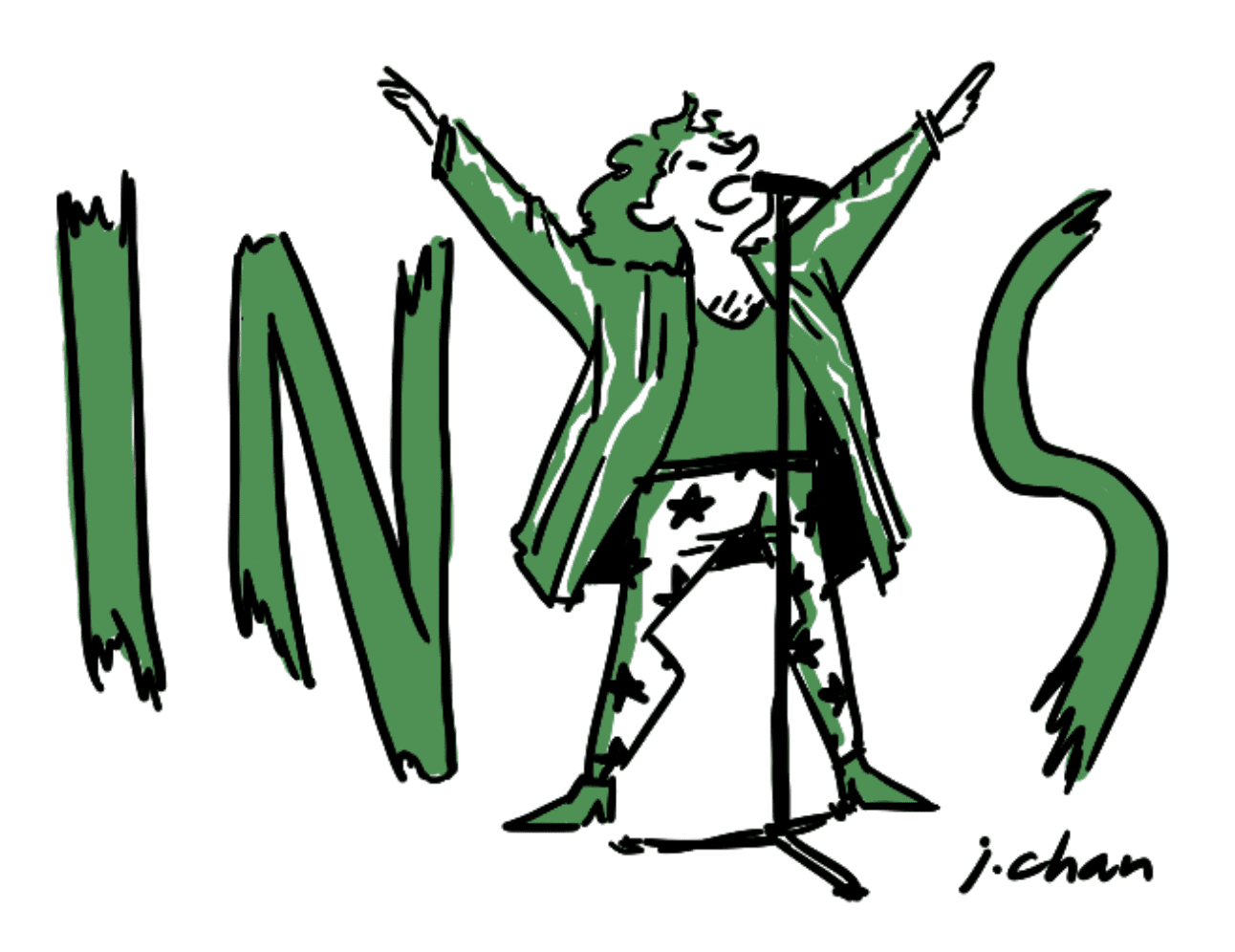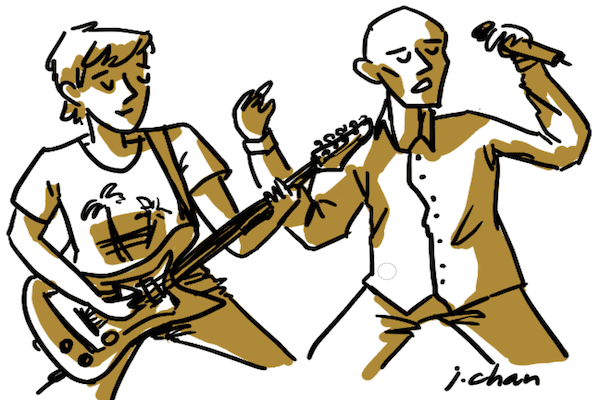There are bizarre elements within the 107-year-long story of the Holme Building’s Refectory. The striking, slightly erotic murals on its back wall, for example, or the fact that their creator reportedly died for a few minutes during the process of creating the final mural. This grand hall has an eccentric flair and a history that links it to the more vibrant and unusual aspects of student culture. These elements are, unfortunately, not exactly reflected by what takes place there now.
The university-related functions that take place underneath its unsettlingly high roof are usually sit-down dinners, cocktail parties and balls. “The kind of USU events you have to google dress codes for,” to quote Sam Langford’s 2016 Honi article. But external events, such as weddings and receptions, corporate dinners and networking nights, are also common. This is all overseen by HostCo, a self-described “boutique catering and venue space nestled in quiet, picturesque gardens.” The company sells itself through the ‘elegance’ and ‘charm’ of the various venues found in the Holme Building, the Refectory being the second largest of these.
My initial feelings towards the Refectory were characterised by a slight grudge regarding soundproofing. For students involved with the Dramatic Society (SUDS), The Refectory is best known for emitting the muffled yet consistently distracting noise that can often be heard from above during performances in the Cellar Theatre.
Usually, it’s during a Saturday night wedding reception, throughout which the oh-so irresistible grooves of whatever wedding band is playing can be heard as they undoubtedly fill up the dancefloor with a slightly funk-oriented pop song. If there was one thing that SUDS’ 2019 production of Relative Values needed, it was a cover of Robin Thicke’s ‘Blurred Lines’ scoring the play’s final act. With a corporatised, dolled up venue encroaching upon a dingy yet communal space of immeasurable significance to student culture, it’s difficult not to see this situation as symbolic, and equally difficult to imagine anything fun happening there.
Hence my surprise late last year when I discovered that some of the most important figures from the Australian rock music canon – Midnight Oil, INXS, You Am I and Hunters & Collectors – had all played the Refectory on several occasions. Not only that, but international bands such as the Smashing Pumpkins, The Lemonheads and They Might Be Giants graced the venue’s stage during their Australian tours. Raymond Ahn, bassist for the seminal Australian punk band Hard-Ons, describes the venue as “a legendary hub of university life, in terms of entertainment.”
As a venue located within a university, the Refectory was part of a larger trend that was occurring at the time where on-campus venues were moved to the centre of the live music scene, both in Sydney and in other major Australian cities. Ex-Rolling Stone editor Toby Creswell says that a lack of venues in Sydney in the 1970s resulted in university shows being a “critical part” of the gig circuit.
“The university was kind of the only place where you could get much by way of cultural activity in Sydney,” he says. “The student union ran everything – they were obviously motivated towards the interest of their members, but also making a very vibrant culture. So venues at universities became an important part of that.”
At that time, many Australian universities would have Entertainment Officers employed through their respective student unions. A “de facto” circuit, as Creswell describes it, involving on-campus venues was formed through communication between these Officers, and became an important stepping stone for up-and-coming bands.
“Uni venues were regarded by musicians as being at the same stature as regular large capacity venues,” says Amanda Brown, formerly of the Go-Betweens. She also notes how beneficial university campuses were for small acts. “A lot of local independent bands were hired because the students booking them were fans… Lloyd Swanton from The Necks says they were given a room at Sydney Uni to practise in for free. That sort of thing is unthinkable now.”

The ideal nature of these campus venues was heightened by the fact that, as music writer Clinton Walker says, they weren’t “at police attention.”
“Uni gigs always had a great vibe because they were kind of… I hesitate to say ‘safe spaces’… but they sort of were.”
“It’s such a different time for me to think about now,” journalist Caleb Cluff says, reflecting on the notable lack of police presence on campus during his time at the University. “There were no security guards everywhere.”
It’s hard to imagine that now. Let’s not forget the words of ex-Head of Campus Security, Simon Hardman in 2013 (when he was the Superintendent of the Newtown Local Area Command): police “do not require any invitation from the University management to enter the grounds and conduct police operations.” If the current lack of live music on campus wasn’t enough to indicate how much less exciting this campus has become since the 70s, the plans to introduce ‘Coffee with a Cop’ sessions last year certainly were.
Back then, the university was a cultural breeding ground; a campus with creativity oozing from even the most unlikely of places. Shows took place in the middle of the day out on the Front Lawns. Tim Freedman, lead singer of The Whitlams, once witnessed Hunters and Collectors playing ‘Throw Your Arms Around Me’ in the Engineering Building (!) before its release.
The Refectory’s visual splendour, size and acoustics made it the ideal space for shows that could be considered “events” – such as the well attended ‘End of Semester’ shows – rather than the smaller “gigs” and band competitions that would take place at other spaces around campus.
Keith Welsh, the manager and a founding member of Icehouse (or Flowers, as they were known during most of his time in the band), reflected on the Refectory’s status. “When it became a regular venue for rock bands, it became one of those points from an artist’s career where they’re getting bigger, or they’re able to play bigger shows.”
The band played at the venue in August of 1979. “We probably would have been headlining that show because we’d hit a point where our album was coming out, things were going well… we could feel a momentum.”
The presence of a “proper stage” in the venue was a great assistance to the band on the night, especially in terms of sound. “So many places that we played would have a pretty loose idea of what a stage was – it could be something on milk crates.”

The shows at the Refectory would often boast a 3-band bill, with headliners needing to have some sort of substantial following. Up and coming bands or acts were far more likely to have their ‘first discovered’ moment elsewhere on campus.
But that’s not to say the Refectory wasn’t enjoyed and remembered fondly by USyd students, indeed the opposite is true. Both Cluff and Ahn named a Go-Betweens show in 1987 as their favourite Refectory story. “It was around the time Robert Forster had taken to wearing slinky sheath dresses and channeling Prince,” Cluff described. “Amanda Brown had joined. My friend Phil Garrett was rather taken by her stage presence, and there ensued a protracted long staring session between Amanda and Phil, which was not unnoticed by Robert. He stopped the gig between songs and with great headmasterly aplomb looked down his nose and pointed directly at Phil. Hilarious and beautiful, like the band.”
Adam Spencer, former president of the USU, recalls seeing The Jon Spencer Blues Explosion “tear the place apart on more than one occasion,” as well as great performances from “real darlings of the indie scene,” such as The Hummingbirds and The Clouds.
What could be considered as a ‘watershed’ moment for the Refectory came in 1977 on May 11, when Brisbane punk band The Saints played the venue with Johnny Dole & The Scabs supporting them. These were two of the leading figures within the Australian punk scene, which was just burgeoning when this gig took place. The Saints had released their debut single, ‘(I’m) Stranded’, in September of the previous year, but with that song alone had predated any recorded musical output by UK punk rock contemporaries such as The Clash, The Buzzcocks and Sex Pistols, and launched the punk and new wave movements in Australia. The explosion of these movements were greatly assisted by the accessibility and inviting and relaxed atmosphere of on-campus venues.
Welsh holds the gig Flowers played at the venue in similarly high regard.
“Physically I remember the venue being fantastic because it was packed, and, as those gigs used to be, it was just fantastic, the response we would get from various people.”
As Welsh suggests, live music was met with a great deal of enthusiasm across campus – an enthusiasm which largely stemmed from the same question that propelled pub rock forwards during this era: what else was there to do? Often costing only $4 or $5, and in a convenient location for those who studied at the university, it was a perfect source of cheap entertainment at a time where there was little else of it – or any kind of entertainment – and an example of the unifying and energising effect of live music and legitimate student culture.
“The whole idea of the audience being that into it – they were all ready to have fun,” Welsh says, “and if the band was good… it was that wonderful symbiotic relationship between the audience and the artist where everybody winds one another up and things get better.”
The social quality of these gigs, as Freedman remembers, was only enhanced by the presence of the Courtyard area (which, at the time, was essentially a set of wooden tables, rather than the open plan café current students know and love). Located just behind where the Refectory’s stage would have been, it was “a great spot to escape noise, drink and talk.”
And on that ‘noise’, one particular feature of the venue was the subject of differing appraisal amongst those who attended gigs there: the sound.
For Welsh, as mentioned before, the experience in this department was nothing but positive, and he believes that “the room was built for there to be good sound.”
“I can recall our front-of-house guy used to be quite specific about trying to get the best sound everywhere, and I remember him remarking that it sounded great that night, whether it’s those old wood panels or whatever it was that was in the room.”
Ahn stated that the ‘blueprint’ strategy employed by sound technicians was to have bands play quieter so that the sound could be ‘pushed out the front’ by the P.A. system. “With that tiny extra bit of reverb… it was a really-good sounding room.”
Ahn recalled seeing Sonic Youth at the venue and witnessing them go into a “free-form segment of their set where they were just playing anything they wanted, it was just pure noise, but it was blissful. Whoever was mixing them did it perfectly.”
However, without a decent crowd, as Freedman says, the same conditions that made the venue’s acoustics optimal for larger gigs (“high ceiling, all hard surfaces”) were its downfall.
Putting it more bluntly, Creswell mentions that he “always found the sound to be really bad in there, it was a pretty horrible experience.”
A particular gig highlighted this for him: in 1979, Skyhooks, who were “on their way out” by that point, played the venue to an audience of what he estimates to be around 12 people. Between the tirades that the band’s bassist subjected their audience to, Toby noticed that “if you don’t have a lot of people in that room, it just sounds terrible, it all bounces around.”
This is, as former USU employee Alistair Cowie confirmed, at least part of the reason why the Refectory no longer hosts gigs. Manning Bar’s multi-million dollar renovation and expansion, finished in 2000, turned it into an ideal, ready-made space for the kinds of gigs the Refectory was known for, but without the need for the expensive and tiresome process of loading in the stage, lights, sound, etc., nor the sound issues that that venue was perceived as having.
What’s more, the safety of the considerably old, wooden-floored Refectory was, according to Cowie, questionable. “I don’t quite know what the capacity is, but I can assure you that the capacity would have been exceeded in those days. I think I remember an INXS concert in there once that had maybe 8 or 900 people crammed in… the floor could only take so much.”

As the heyday of the pub rock phenomenon continued throughout the 80s, more venues began to emerge – specifically, venues that were more successful in meeting the criteria of the industry at the time, which Toby believes “was built around how much beer you could sell.”
While the decision to can gigs at the Refectory may not exactly be part of a grand conspiracy involving the University’s endless quest to ban fun, there were other factors at play aside from those cited above.
Live music in Sydney has been experiencing what Clinton Walker labels a “death by a thousand cuts” for several decades now. Some of these “cuts” included regulations regarding the safety and noise levels of venues, and, of course, poker machines.
But the bigger blow to campus culture was the introduction of Voluntary Student Unionism and, subsequently, the USU’s ACCESS program, in 2006. The reasonable budget that universities had allocated to cultural and social events before this was no longer seen as viable. Thus came a decrease in students’ engagement in the campuses’ cultural offerings.
Amanda Brown, formerly of the Go-Betweens, saw live music on campus as one of the “first casualties” of “the introduction of broader fees and the pressure to turn a profit rather than offer a well rounded education (including a vibrant campus social life).”
Going back further, a political shift occurred on campuses during the late 1970s and beyond. Creswell describes watching on “as this sort of conservatism started to sneak further and further into [the student body]”. On-campus demonstrations decreased and an activist culture was “leached out.” Both Creswell and Walker stressed the importance of this aspect of student culture to the live music scene on campus. “Music was completely intrinsic to political activism,” says Walker.
But the Refectory was more separate from this culture than other venues on campus. It did not have the same grassroots agenda as, for instance, shows at the Tin Sheds, an art workshop near where the Wentworth Building currently is that was completely run by students at the time.
The gigs that occurred in the Refectory weren’t as frequent as other spaces, nor did they showcase that much by way of ‘underground’ music. The kinds of events that take place at the Refectory now aren’t new. Graduation ceremonies, weddings, college functions – they were all happening during the day (though corporate events weren’t as common as they are now).
Live music on campus is no longer the cultural force it once was. Of course, musical societies will organise their own performances, and take the stage during O-Week, though the collective organisation that was inherent to live music in the past is nowhere to be found.
The live music that does go on at Manning and Hermann’s Bar feels distinctly separate from student culture. You’d be lucky to see any sort of substantial promotion of these shows from the student union that was once running them.
According to setlist.fm, the last gig to take place at the Refectory was as far back as April 7, 2000, when The Whitlams played there to a “full house.” Tim recalled seeing the crowd through the large windows which line the venue’s ‘colonnade’ while walking through there to get to the stage. If this was, in fact, the last gig to take place there, at least it would have been a packed one.
The birth of the idea behind this article came from a perception of the Refectory as a victim of gentrification – a symbol for the demolishment of an authentic student culture that has been replaced by corporatised schmoozefests and boring cocktail parties for college kids.
In some ways, this is true. Yet, as Toby described it, USyd used to be a “melting pot university,” and that is, perhaps, what the Refectory was actually symbolic of. It can still be said, though, that what the pot cooks up nowadays doesn’t have as much spice as it used to.
Maybe the Cellar Theatre’s roof can be thankful for that, at least.
Art by Jocelin Chan.





